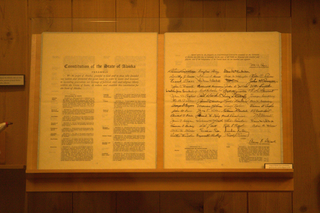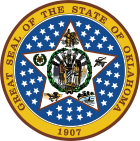
The Constitution of the United States is the supreme law of the United States. It superseded the Articles of Confederation, the nation's first constitution, on March 4, 1789. Originally including seven articles, the Constitution delineates the national frame and constrains the powers of the federal government. The Constitution's first three articles embody the doctrine of the separation of powers, in which the federal government is divided into three branches: the legislative, consisting of the bicameral Congress ; the executive, consisting of the president and subordinate officers ; and the judicial, consisting of the Supreme Court and other federal courts. Article IV, Article V, and Article VI embody concepts of federalism, describing the rights and responsibilities of state governments, the states in relationship to the federal government, and the shared process of constitutional amendment. Article VII establishes the procedure subsequently used by the 13 states to ratify it. The Constitution of the United States is the oldest and longest-standing written and codified national constitution in force in the world.

Article One of the Constitution of the United States establishes the legislative branch of the federal government, the United States Congress. Under Article One, Congress is a bicameral legislature consisting of the House of Representatives and the Senate. Article One grants Congress various enumerated powers and the ability to pass laws "necessary and proper" to carry out those powers. Article One also establishes the procedures for passing a bill and places various limits on the powers of Congress and the states from abusing their powers.

The Twenty-third Amendment to the United States Constitution extends the right to participate in presidential elections to the District of Columbia. The amendment grants to the district electors in the Electoral College, as though it were a state, though the district can never have more electors than the least-populous state. How the electors are appointed is to be determined by Congress. The Twenty-third Amendment was proposed by the 86th Congress on June 16, 1960; it was ratified by the requisite number of states on March 29, 1961.

The Territory of Oklahoma was an organized incorporated territory of the United States that existed from May 2, 1890, until November 16, 1907, when it was joined with the Indian Territory under a new constitution and admitted to the Union as the state of Oklahoma.

The State of Sequoyah was a proposed state to be established from the Indian Territory in the eastern part of present-day Oklahoma. In 1905, with the end of tribal governments looming, Native Americans of the Five Civilized Tribes—the Cherokee, Choctaw, Chickasaw, Creek (Muscogee), and Seminole—in Indian Territory proposed to create a state as a means to retain control of their lands. Their intention was to have a state under Native American constitution and governance. The proposed state was to be named in honor of Sequoyah, the Cherokee who created a writing system in 1825 for the Cherokee language.

The Constitution of the State of Tennessee defines the form, structure, activities, character, and fundamental rules of the U.S. State of Tennessee.

Charles Nathaniel Haskell was an American lawyer, oilman, and politician who was the first governor of Oklahoma. As a delegate to Oklahoma's constitutional convention in 1906, he played a crucial role in drafting the Oklahoma Constitution and gaining Oklahoma's admission into the United States as the 46th state in 1907. A prominent businessman in Muskogee, he helped the city grow in importance. He represented the city as a delegate in both the 1906 Oklahoma convention and an earlier convention in 1905 that was a failed attempt to create a U.S. state of Sequoyah.

The Constitution of the State of Florida is the document that establishes and describes the powers, duties, structure, and function of the government of the U.S. state of Florida, and establishes the basic law of the state. The current Constitution of Florida was ratified on November 5, 1968.
State ratifying conventions are one of the two methods established by Article V of the United States Constitution for ratifying proposed constitutional amendments. The only amendment that has been ratified through this method thus far is the 21st Amendment in 1933.

The Constitution of the State of Michigan is the governing document of the U.S. state of Michigan. It describes the structure and function of the state's government.
The Constitution of the State of Ohio is the basic governing document of the State of Ohio, which in 1803 became the 17th state to join the United States of America. Ohio has had three constitutions since statehood was granted.
The Constitution of the State of New York establishes the structure of the government of the State of New York, and enumerates the basic rights of the citizens of New York. Like most state constitutions in the United States, New York's constitution's provisions tend to be more detailed and amended more often than its federal counterpart. Because the history of the state constitution differs from the federal constitution, the New York Court of Appeals has seen fit to interpret analogous provisions differently from United States Supreme Court's interpretation of federal provisions.

The Constitution of the State of Alaska was ratified on April 4, 1956 and took effect with Alaska's admission to the United States as a U.S. state on January 3, 1959.
The Constitution of the State of Wisconsin is the governing document of the U.S. State of Wisconsin. It establishes the structure and function of state government, describes the state boundaries, and declares the rights of state citizens. The Wisconsin Constitution was written at a constitutional convention held in Madison, Wisconsin, in December 1847 and approved by the citizens of Wisconsin Territory in a referendum held in March 1848. Wisconsin was admitted to the United States on May 29, 1848. Although it has been amended over a hundred times, the original constitution ratified in 1848 is still in use. This makes the Wisconsin Constitution the oldest U.S. state constitution outside of New England. Only Massachusetts, New Hampshire, Vermont, Maine, and Rhode Island use older constitutions.
In the United States, term limits restrict the number of terms of office an officeholder may serve. At the federal level, the president of the United States can serve a maximum of two four-year terms, limited by the 22nd Amendment to the United States Constitution. Some State government offices are also term-limited, including executive, legislative, and judicial offices.
The Constitution of the State of Arizona is the governing document and framework for the State of Arizona. The current constitution is the first and only adopted by the state of Arizona.

The Constitution of Indiana is the highest body of state law in the U.S. state of Indiana. It establishes the structure and function of the state and is based on the principles of federalism and Jacksonian democracy. Indiana's constitution is subordinate only to the U.S. Constitution and federal law. Prior to the enactment of Indiana's first state constitution and achievement of statehood in 1816, the Indiana Territory was governed by territorial law. The state's first constitution was created in 1816, after the U.S. Congress had agreed to grant statehood to the former Indiana Territory. The present-day document, which went into effect on November 1, 1851, is the state's second constitution. It supersedes Indiana's 1816 constitution and has had numerous amendments since its initial adoption.

The Constitution of the State of New Mexico is the document that establishes the fundamental political framework of the U.S. state of New Mexico. It sets forth the principles and structure of government, enumerates the rights of citizens, and functions as the supreme law of the state, subordinate only to the United States Constitution.

In the United States, a state is a constituent political entity, of which there are 50. Bound together in a political union, each state holds governmental jurisdiction over a separate and defined geographic territory where it shares its sovereignty with the federal government. Due to this shared sovereignty, Americans are citizens both of the federal republic and of the state in which they reside. State citizenship and residency are flexible, and no government approval is required to move between states, except for persons restricted by certain types of court orders.
The Sequoyah Constitutional Convention was an American Indian-led attempt to secure statehood for Indian Territory as an Indian-controlled jurisdiction, separate from the Oklahoma Territory. The proposed state was to be called the State of Sequoyah.













